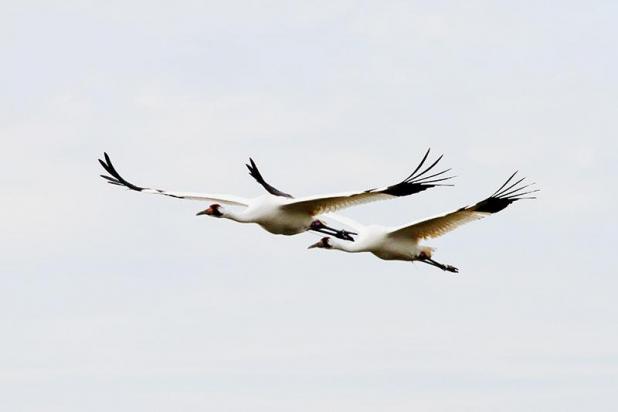
Whooping cranes passing The Daily Review Outdoor Writer John Flores’ blind in a rice field on White Lake Conservation Area near Gueydan. (Submitted Photo/Courtesy of John K. Flores)
Whooper sighting shows population is stable
Some of the best moments I’ve ever had in a duck blind or deer stand have been those instances when no game bird or animal was flying or moving. During those periods, I’ve often seen non-game species of birds and mammals I wasn’t likely to experience had I been blasting away at avian targets or on high alert for a big buck.
Take the time I was sitting on a tripod deer stand overlooking the marsh near Salt Point on East Cote Blanche Bay. Around midmorning, I watched an otter cross a little bayou. For some reason, it followed the trail I walked in on and curled underneath my stand and went to sleep.
I watched that otter for the better part of an hour until it suddenly woke and continued on its way. It was one of those special days in the stand that I didn’t fire a shot.
Recently, I had one of those special moments while on a lottery rice field hunt on White Lake Wetlands Conservation Area property. One of my hopes and desires has been to see whooping cranes grace the skies of Louisiana again. What’s more, see it in my lifetime.
As a “young” senior, I figured my time was ticking, so the non-essential experimental populations that were first introduced in 2011 better get cracking adapting, maturing and nesting here in the state.
My buddy Rick and I were, as they say, “shooting the bull,” around 9 a.m., when something big and white caught my eye out beyond our decoys.
“What are they?” my friend said.
To which I replied, “This is a good day and a great hunt. Those are whooping cranes, and I finally get to see them in the wild for the first time.”
Oh sure, I had some things in my favor. After all, White Lake Conservation Area has been pretty much ground zero for reintroduction of the experimental population. However, White Lake is some 71,905 acres in size, and I was nowhere near their release site or the pens where their acclimation takes place.
As a guy who always carries his camera with him, on this particular morning, I hadn’t pulled it out of my blind bag. Thus, I missed the shot.
As exciting as it was to see these endangered species fly past the blind, I was a little bummed I missed the opportunity to photograph them.
No sooner had I gotten over my pity-party when four more whoopers came from somewhere behind us and flew past my buddy’s end of the blind 100 yards or so away. Again, I wasn’t ready.
Mumbling something to the effect, “that’s just stupid, John. Get your camera out,” I dug into my bag hoping the good Lord would somehow entice those birds to give me one more pass. And sure enough, a third opportunity presented itself when two more cranes did a flyby approximately 60 to 80 yards out in front of the blind.
I should note that we’re talking about a bird that reaches 5 feet in height and has a wingspan of 7 to 8 feet. Even at that distance, I knew I could get a pretty decent shot with my telephoto lens zoomed out to its maximum focal length of 400mm. The image I got clearly showed the colored leg bands on each bird.
When I got home, I immediately processed the images and reported them to the Louisiana Department of Wildlife and Fisheries, which has a dedicated location on their website for reporting whooper sightings. It also allows images to be attached.
Louisiana Department of Wildlife and Fisheries Wildlife Technician, Eva Szyszkoski sent me an email saying that the two whooping cranes I photographed were identified as L13-16 and L10-17. The first two numbers represent the hatch order and the second two the year hatched.
In sharing a little bit about my two birds, Szyszkoski said, “They are relatively new as a pair. L10-17 had previously been hanging out with another male, whom she met up with in Louisiana. She followed him back to a location he uses a lot in Jefferson County, Texas, where male L13-16 was at the time.”
Szyszkoski continued saying, “The trio came back to Louisiana not long ago and apparently L13-16 and L10-17 separated themselves as a pair – meanwhile, the other male returned to Texas. But, due to her young age, it’s unlikely that they will have a nest with eggs this coming spring – if they remain together – but nothing is impossible.”
According to the most recent general population update released by the Louisiana Department of Wildlife and Fisheries, the current population of whooping cranes stands at 63 individuals (28 males, 33 females and two unknown). The current distribution of the non-migratory population shows 54 cranes in Louisiana, eight in Texas and one in Arkansas.
Additionally, the department says 12 more juveniles held in a release pen on Rockefeller Wildlife Refuge will eventually be added to the total after they are released. The department’s goal is to establish a population of 120 to 132 whooping cranes, with 25 to 30 breeding and nesting pairs.
EDITOR’S NOTE: Flores is The Daily Review’s Outdoor Writer.
